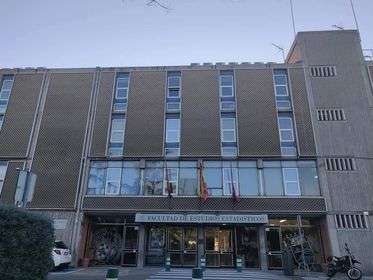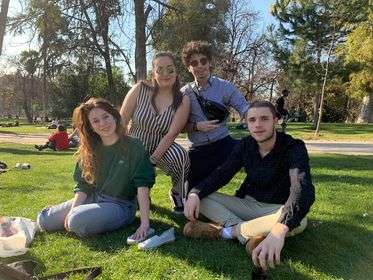Study in Madrid: Anaïs, Erasmus+ student at Complutense
Anaïs Fernandes, ENSAI class 2021, flew to Madrid and its Universidad Complutense in January 2020. At the time, there was no indication that her Erasmus+ stay would be shortened due to a pandemic. Nevertheless, she enjoyed her Spanish experience so much, first on site and then remotely, that she wants to return to Madrid one day.
Complutense de Madrid welcomes about 80,000 students in 26 faculties, including the Faculty of Statistical Studies.
From the Ker Lann campus to Plaza del Sol
Anaïs Fernandes: “After B/L preparatory classes in Strasbourg and two years of MASS (Applied Mathematics and Social Sciences) studies in Lille, I came to ENSAI because I liked the combination of Mathematics, Economics, and Computer Science. I chose Statistics and Data Engineering as my 3rd year specialization course. Computer Science became a passion of mine during my Bachelor’s degree, and I want it to be central in my future career.
So why did I choose to study at the Universidad Complutense de Madrid? As I had already been an Erasmus student at Trinity College in Dublin during my undergraduate degree, I wanted to experience life in a southern European country, known for its friendliness, its offbeat and festive lifestyle, and its universities that favor application over theory.
I wanted to see another way of learning Statistics and I was not disappointed! I also wanted to challenge myself by taking courses in Spanish. I took Spanish from 4th grade to the first year of preparatory classes and, being fluent in Portuguese, I hoped to improve very quickly.
Unfortunately, I only stayed in Madrid for two months because of the pandemic. I do feel like I stayed much longer, though, because I managed to do many different things and finished my semester by taking the courses from Madrid online.
A typical day at Complutense de Madrid
The first class starts between 11am and 1pm. After taking the subway in Sol, one of the most beautiful plazas in Madrid, I would take the bus to go to the Faculty of Statistics, on this huge campus. Before entering class, I would always take time to admire the snowy mountains in the distance.
Classes didn’t always start on time, and sometimes we would wait up to 20 minutes for our students and/or teachers. Spain is known for its flexibility with time! The first few times were surprising, I would wonder if I was in the wrong room and then I got used to it very quickly. (Be careful, some teachers hate tardiness. Don’t make a rule out of it).

The Faculty of Statistics
Lunch break starts at 3pm. I took advantage of this time to go to the library to study before my evening class, from 6 to 9 pm.
After this last class, I had several options. Sometimes, just went home to rest before starting early the next day. Other times, I would go watch soccer games with my classmates (even when you don’t like soccer, being interested in it will help you make friends) or we would go for a drink and eat tapas. There are worse things, don’t you think?
Courses in a Spanish university
During my Erasmus stay, I took three Bachelor’s courses and two Master’s courses. A Bachelor’s course is divided into two 2-hour sessions per week. A Master’s course amounts to one session of 3 hours per week.
I opted for a C++ course because it was best for me to know this language for the Statistics and Data Engineering specialization in my third year at ENSAI. I had a lecture and a seminar every week. I had to code two projects, a kind of mastermind and an application to manipulate data in a database (deleting, adding an individual, etc…). In the particular health context, we were evaluated on these projects as well as on multiple choice tests.
I also followed a course on advanced prediction techniques. Each session started with theory and ended with a mini seminar of application. We used SAS. At the end of each topic, we had a seminar that included all the concepts we went over. I really appreciated this balance: the best way for me to understand the theory behind the practice.
The multivariate statistical techniques course was based on the notions of the linear regression course and reviewed several models. The professor alternated between theoretical courses and applications on SPSS (a push-button software similar to SAS). The evaluation was an oral. At the end of each topic, we had to find a database that matched the model and predicted future values.
The duration modeling course I was taking was taught by a biostatistics lecturer and researcher. This course allowed me to get acquainted with scientific research articles (in English and Spanish), beyond the discovery of Biostatistics. We used R and sometimes STATA.
Finally, I had chosen a course in Bayesian Calculus. I discovered a different approach to Statistics. The course also mixed theory and practice, with R and OpenBUGS.
Complutense pedagogy, or the theory/practice balance
Mind you, I didn’t just have fun in Madrid, I also learned a lot! As you can see, working methods are very different in Spain. Understanding theory requires a lot of application and evaluation.
When a concept is not acquired, you are given new chances to prove yourself. The main thing is not to provide knowledge at a given moment, but to learn for good.
I really appreciated the fact that oral presentations and continuous assessment were favored. I am someone who understands better by doing. There isn’t a single course in Madrid that I didn’t like or didn’t understand. The support and flexibility of the teachers also comes from the small class sizes, which rarely exceed 25 students. In addition, most of my teachers were women: they inspired me and I could relate to them.
I feel that this semester allowed me to understand many things, to see connections between the subjects, but also between classes and real life. And I was able to improve my oral and written expression in Spanish.
The health situation shortened my experience by 4 months. Even though I did follow the classes from Madrid online, I was no longer in Spain and could no longer enjoy this incredible city. I would like to do my end-of-studies internship in Madrid to finish visiting the city, to become truly bilingual, and to live ”en español” a little more.
Some advice before an international exchange
Whether one wishes to live “la vida loca or rather experience Hygge, the process is the same. For an Erasmus experience that goes well, I would advise you to choose courses that do not overlap on the timetable, to know who will have to sign the arrival papers, and where that person is.
Think about the cost of living: shopping, going out, housing… Do not rush to find a place to live if you are not sure that it is suitable for you. Ask ENSAI students where they stayed and if they have any contacts. Take a roommate or a room in a student hall to be with people in the same situation.

ENSAI fellow students came to visit!
Find out about transportation passes and whether or not you need to register as a foreign resident in your city. Follow the ESN of your city on social networks and go to their events. Be present at the pre-study orientation to meet people and visit the host university.
And above all, make the most of every moment, la vida es chula!“.
Find out more about ENSAI’s international partnerships.
